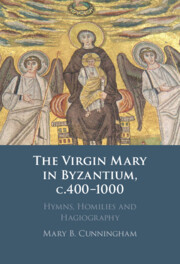Acknowledgements
This book has been in preparation for a long time and it is wonderful at last to have completed it. I am delighted to acknowledge here the help, both financial and intellectual, that contributed to this project. I would like first to thank the British government funding body, the Arts and Humanities Research Council (AHRC), for supporting a three-year project at the University of Birmingham between 2003 and 2006 on the Virgin Mary in Byzantium. The project was led by Professor Leslie Brubaker, of the Centre for Byzantine, Ottoman and Modern Greek Studies within the Institute of Archaeology and Antiquity, and it provided a three-year research post for me at the University of Birmingham. I thus owe thanks to that institution, which furnished me with both financial assistance and bibliographical resources during that initial phase of the project. The Department of Theology and Religious Studies at the University of Nottingham, which offered me a Lectureship from 2006 onward, supported my research activities for the next ten years and I remain indebted to that institution for its belief in my scholarly and teaching abilities. Following this, I was offered a one-year Fellowship at Dumbarton Oaks Research Library and Collection in the academic year 2015–16. I worked specifically on this project throughout that year, which helped immeasurably in pushing it towards completion. In addition to giving me access to its unparalleled library and museum resources, Dumbarton Oaks provided a friendly community in which I learned much from the other Fellows and Junior Fellows. I would like to express my deepest thanks to all three of these institutions in which I enjoyed such dynamic and productive intellectual exchanges with fellow teachers and scholars.
As for the many individuals who helped me to complete this project, I would like to acknowledge first my original director and collaborator, Leslie Brubaker. She took the initiative in submitting a proposal to the AHRC in 2002, overseeing its successful completion and advising me not only during the three years of official funding but also thereafter. It is unfortunate that our respective work schedules did not in the end allow us to write this book together; however, Leslie graciously agreed that it would make better sense for each of us to write separate works. We hope that the two volumes, which will cover the textual and the material evidence for the cult of the Virgin Mary during the early and middle Byzantine periods, will complement each other since they both reflect the aims of our joint project. In addition to providing stimulus at the beginning of the project, Leslie read and commented on various chapters that I wrote in the years that followed. I would also like to thank Thomas Arentzen, Fr Maximos Constas, Stig Frøyshov, Susan Ashbrook Harvey, Dirk Krausmüller and Andrea Olsen Lam, who have read either the whole or separate parts of the book and offered valuable criticisms. I take full responsibility for any errors that remain. In addition to those scholars, Pauline Allen, Theodora Antonopoulou, Barbara Crostini, Beatrice Daskas, Francesca Dell’Acqua, Uffe Holmsgaard Eriksen, Jeffrey Michael Featherstone, Georgia Frank, Antonia Giannouli, Brad Hostetler, Ally Kateusz, Karen Kilby, Derek Krueger, Fr Andrew Louth, Wendy Mayer, Andrew Mellas, Fr Damaskinos Olkinuora, Leena Mari Peltomaa, Maroula Perisanidi, Nancy Ševčenko, Stephen Shoemaker, Christos Simelidis, Kosta Simić, Alice-Mary Talbot, Gabrielle Thomas, Niki Tsironis, Annemarie Weyl Carr, Monica White and Mary Whitby have provided me with ideas and advice over the years. Michael Whitby suggested several important corrections, for which I am grateful. There are many other colleagues, whose names are too numerous to list, who have also assisted me. Professor Dame Averil Cameron helped me to overcome my doubts and complete the manuscript in the course of the last year – for that, along with the inspiration that she has provided by means of her own contributions to the subject, I remain hugely grateful. Two anonymous readers offered useful advice and approved my manuscript for publication. Terry J. Wright compiled the index for me, thus relieving me of a technical challenge that I found difficult to face. Michael Sharp has been immensely helpful during the preparation of this work and I would like to take this opportunity to thank him along with the rest of the production team at Cambridge University Press. Thanks are also due to Kay McKechnie, the copy-editor, who saved me from many errors as we prepared the manuscript for publication.
Finally, I would like to express my gratitude and love for various close friends and family members who have encouraged me throughout my career – and sometimes especially with respect to this project. My children, Emily and James, generously believed in a career that frequently distracted my attention from themselves. Emily, since becoming a successful scholar herself, has been an indefatigable and helpful mentor with regard both to the bigger questions and to detailed matters of presentation. My sisters, Sarah and Conti, provide me with moral support and love, as our parents did throughout their lives. Finally, I would like to acknowledge the enduring encouragement of my husband, Richard Corran, who has always stood behind whatever enterprise I undertake. I hope that this offering is worthy of the ‘infinitely capacious’ and compassionate Mother of God who is its subject.



